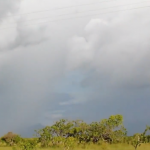
The Hydromet Office on Wednesday issued a seasonal forecast for Guyana and predicted that rainfall during the Christmas season is expected to be above average.
The increase in rainfall can, in some instances, result in localized flooding and an upsurge in mosquito breeding and other moisture related pests, it cautioned.
“The output from the Seasonal Climate Outlook model for November 2017 to January 2018 suggests higher chances (85-90%) of above-average rainfall across Guyana (average for northern Guyana is 600mm, and 130 mm for southern Guyana),” the forecast noted.
The highest rainfall totals are expected in Regions 1 to 6, 7 and 10; Region 9 will continue to be relatively dry.
The met office said, usually, northern Guyana would experience 40 to 64 rain days (days with more than 1 mm of rainfall) from November to January. The Seasonal Climate Outlook model suggests there will be between 46 to 65 rain days in the upcoming rainfall season.
The Met Office further explained that northern Guyana is currently transitioning into the secondary wet season which is forecasted to begin during the second half of November, 2017.
Based on historical records (climatology), this season is expected to conclude by mid-February, 2018; while southern Guyana’s dry season is expected to continue until mid-April 2018.
Cooler than average sea-surface temperatures (SSTs) of approximately 0.5°C have been recorded in the eastern Equatorial Pacific.
Model consensus is that these conditions will continue well into January, 2018.
In addition, the atmospheric conditions over the eastern Equatorial Pacific are consistent with cold neutral to borderline weak La Niña conditions. The La Niña phase of the El Niño Southern Oscillation (ENSO) usually results in an increase in precipitation in Guyana.
“The Inter – Tropical Convergence Zone (ITCZ) has begun its southern migration and is currently oscillating between 6º N and 10 ºN Latitude (between northern Guyana and Trinidad and Tobago),” the statement added.

Additionally, upper atmospheric troughs with accompanying jet streams are being observed in the vicinity this area. These and other dynamic and thermodynamic features indicate that the secondary rainy season is looming.
The forecasted higher chances of above-average rainfall is expected to recharge reservoirs, conservancies and aquifers, limiting local concerns of drought in northern Guyana.
Farmers are advised to keep their drains clear in order to prevent flooding on farms, especially those located in flood-prone areas.
Further, special attention should be paid to short-range forecasts provided by the Hydrometeorological Service in order to plan daily farm activities such as fertilizers and pesticides applications. Consideration should also be given to planting crops that are water tolerant during the forecast period.
The Hydrometeorological Service will provide updates to its seasonal forecast as new information becomes available.
For short range forecasts and weather analyses, stakeholders are advised to follow the Daily Weather Briefs, Outlooks and Advisories produced by the National Weather Watch Centre or visit www.hydromet.gov.gy. The forecast desk can be reached at 261-2284/261-2216.











You must be logged in to post a comment Login